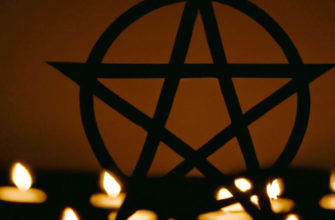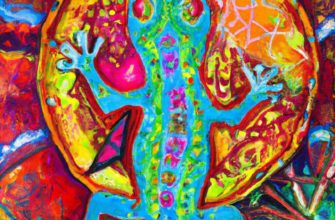To gain a deeper understanding of fire symbolism, explore its different aspects. Define fire symbolism and learn about its significance in various cultures and religions. Embrace the rich cultural and spiritual meanings attached to the element of fire.
Definition of Fire Symbolism
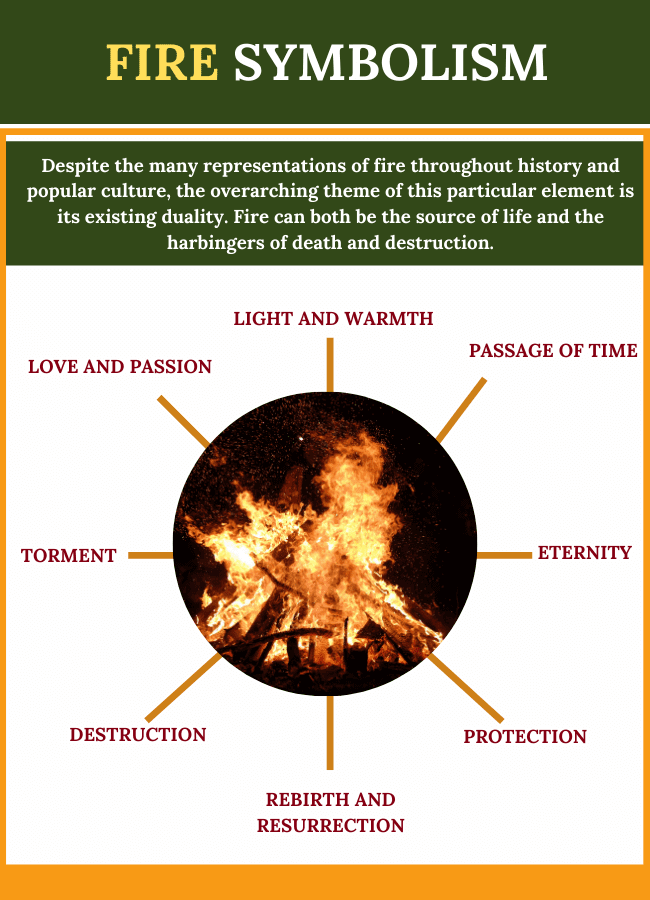
Fire is a powerful symbol with profound meaning in various cultures and mythologies. It can represent passion, transformation, and purification. Fire is both destructive and creative. It can spark creativity and also embody divine intervention.
Fire symbolism has an extensive history and is deeply embedded in human culture. Ancient rituals and modern celebrations have utilised fire. The eternal flame is often used to symbolise perpetual life or remembrance. Enlightenment is represented by bright flames in spiritual traditions.
The Great Fire of London in 1666 is an example of fire symbolism leaving a lasting impression. The fire destroyed thousands of buildings and changed architectural practices for centuries. Notable works of art depicting the fire still resonate today.
Fire symbolism continues to fascinate and intrigue us. As we explore its multifaceted meanings, we can appreciate its transformative power.
Importance of fire symbolism in various cultures and religions
Fire has entranced the human imagination for centuries. It stands for transformation, purification and spiritual enlightenment. In cultures and religions worldwide, it symbolizes creation and destruction.
Hinduism has Agni, the god of fire. Fire ceremonies are performed to purify and transmute negative energies into positive ones. Ancient Greek mythology has Prometheus stealing fire from the gods to bring civilization to humanity.
Christians consider fire as a manifestation of God or divine inspiration. Moses encountered a burning bush in the Book of Exodus, symbolizing God’s communication with humans. Pentecost is celebrated with tongues of fire representing the holy spirit.
Native Americans view fire as sacred, connecting them with ancestors and nature spirits. Rituals involving fire express gratitude, healing and spiritual cleansing.
The Great Fire of Rome in 64 AD was an infamous event. Emperor Nero blamed Christians and used it to persecute them, leading to severe religious persecution.
Historical and Cultural Significance of Fire Symbolism
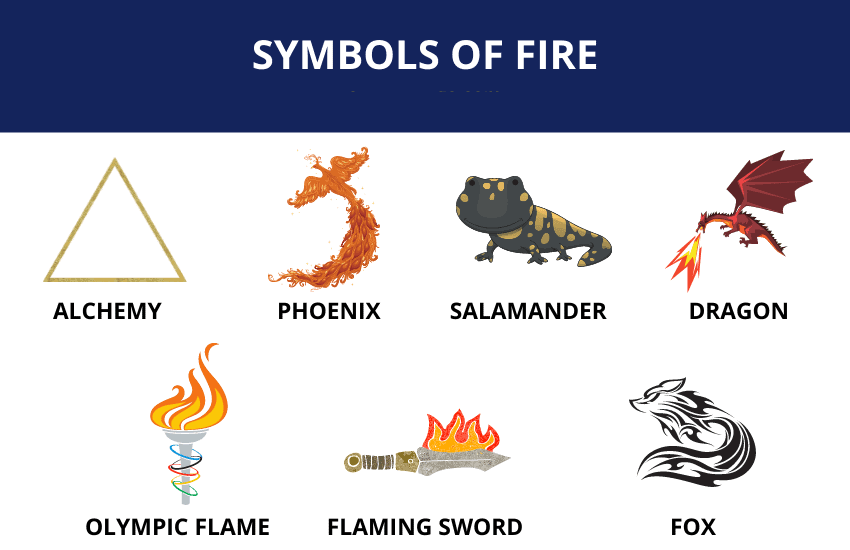
To understand the historical and cultural significance of fire symbolism, delve into the realm of ancient civilizations and major religions. Explore how fire symbolism played a crucial role in shaping the beliefs and practices of various cultures throughout history.
Fire symbolism in ancient civilizations
Ancient civilizations had a deep reverence for fire. In Egypt, it was seen as a source of light, warmth and purification, representing the cycle of life and death. In Greece, it embodied transformation and creation, associated with Hephaestus, the god of blacksmiths and craftsmen. In China, it symbolised Qi, the vital energy flowing through all living beings. Native American cultures viewed fire as connecting humans to the divine realm, representing spiritual illumination.
The Mayans had a unique interpretation – believing that fire had a dual nature, capable of both destruction and renewal. This idea further heightened their respect for the element in their rituals and ceremonies.
Seneca once said, “A spark neglected burns the house.” An insightful reminder of the potential danger of fire!
Fire as a symbol of purification and transformation in ancient Egypt
Fire has long been a symbol of purification and transformation in ancient Egypt. The flames were believed to cleanse impurities and renew spiritual energy. Fire rituals and offerings were conducted to seek divine favor. They also represented a transformative power, allowing individuals to shed their old selves and emerge anew.
Fire was practical too. It was used for cooking, providing warmth, and crafting pottery. It was an essential part of everyday life.
The Temple of Luxor is a great example of fire’s importance. Legend says it was constructed with fires continuously burning to honor the gods and ensure their protection. This shows how much reverence fire was given, and its association with permanence and stability.
Fire was central to religious rituals, daily life, and the construction of the Temple of Luxor in ancient Egypt. It is clear how influential it was within this remarkable civilization.
Fire as a symbol of divine power in ancient Greece and Rome
Fire has been held as a symbol of divine power since ancient Greece and Rome. It was seen to show the gods’ authority and strength. Flames atop altars were thought to be a connection between mortals and the gods. This fire was also linked to purification and spiritual growth. Sacrifices made in its presence were to please the gods.
These beliefs resulted in fire being used in religious ceremonies. The flame at temples devoted to gods such as Hestia and Vesta was tended to by vestal virgins – it was a representation of divine presence.
In literature, fire stood for passion, vitality and intensity. It was used metaphorically to give strength to ideas and emotions.
Exploring the symbolism of fire in ancient Greece and Rome, we can see how this element was seen as an embodiment of divine energy. Thinking about these associations makes us curious to learn more about these cultures.
Let’s take a journey through time to uncover the amazing symbolism of fire in different civilizations. Discover the hidden depths of our shared history!
Fire as a symbol of enlightenment and spiritual awakening in ancient India
Fire has been held in high regard since olden times in India. Its meaning, linked to enlightenment and spiritual awakening, is steeped in the country’s cultural and historical traditions. Let us explore the many ways in which fire symbolizes enlightenment and spiritual awakening.
| Aspect | Significance |
|---|---|
| Agni, the God of Fire | Agni, the Vedic deity, is the God of Fire. He is revered for his connection to illumination, transformation, and cleansing rituals. |
| Yajna – The Sacred Ritual | Fire is an important part of Yajna, a ritual to seek divine blessing and link to higher consciousness. It is seen as the bridge between humans and deities. |
| Inner Transformation | Fire symbolizes inner transformation and purification of the mind from negative thoughts. Ancient texts often reference this as “burning away impurities” through self-awareness and realization. |
Fire symbolism extends beyond these aspects to include other unique details that make it even more meaningful. For example, the flame’s upward direction shows our connection to higher realms and aspiration for spiritual growth. Additionally, fire serves as a beacon of light in the darkness and ignorance on our journey to self-discovery.
Moreover, fire has its own history in ancient India. The Rigveda, one of the oldest scriptures, includes hymns to Agni, praising him for his transformative and illuminating powers. This highlights how fire symbolism has been a part of Indian spiritual and cultural life for many generations.
Fire symbolism in major religions
Fire possesses great mystical power in major religions. Let us delve into this captivating topic and discover how this element is symbolized in different religious traditions.
In Christianity, fire stands for the Holy Spirit and is typically linked to purification and revival. It symbolizes God’s existence, as seen in the burning bush which Moses encountered.
In Hinduism, fire is considered sacred and it plays an essential role in rituals. Agni, the god of fire, is worshipped as a communicator between humans and their gods. Fire stands for divine knowledge, transformation, and freedom.
In Buddhism, fire symbolism is connected with light and enlightenment. The flame of a candle symbolizes enlightenment and deliverance from misery. It indicates the presence of the Buddha’s teachings which guide people towards awakening.
In Judaism, fire has both good and bad associations. On one hand, it symbolizes God’s divine presence as shown by the eternal flame in many synagogues. On the other hand, it can be related to destruction and punishment.
Exploring deeper into this immense tapestry reveals even more interesting aspects of fire symbolism across major religions.
So, find out for yourself the profound meaning of these ancient symbols. Uncover how fire ties humanity to its spiritual origins and offers a look into sublime realms. Don’t miss out on uncovering the secret depths of knowledge that these powerful symbols of divine link contain.
Fire symbolism in Christianity
Fire symbolism in Christianity is loaded with historical and cultural significance. Fire is a symbol of many things, such as purification, enlightenment, and divine presence.
Let’s explore the symbolic meaning of fire in Christianity:
| Aspect | Symbolic Meaning |
|---|---|
| Purification | Cleansing and removal of impurities |
| Enlightenment | Knowledge, illumination, and wisdom |
| Divine Presence | The presence of God or the Holy Spirit |
| Transformation | Spiritual growth and inner change |
The symbolic meaning of fire in Christianity goes beyond its literal interpretation. It is a powerful metaphor for transformation and renewal in people. Plus, it reminds believers of the eternal flame that burns with devotion for their faith.
Pro Tip: When talking about fire symbolism in Christianity, go beyond the words. Delve into the history and culture to get a full understanding and appreciation of its deep meaning.
Fire symbolism in Buddhism
Fire in Buddhism is a powerful metaphor for transformation, purification and enlightenment. It is seen as a purifying force that can burn away negative karma and lead to spiritual growth.
The fire offering ritual is an essential part of Buddhist ceremonies. Devotees offer objects or prayers in fire to express their devotion and surrender to the divine.
Burning desire symbolizes the powerful longing for spiritual awakening. It encourages individuals to pursue enlightenment single-mindedly, forsaking worldly temptations.
Fire’s ability to illuminate darkness is a metaphor for wisdom and insight. It dispels ignorance and delusion, enabling one to see reality more clearly.
Lastly, fire signifies destruction, but of negative things like ignorance and suffering. It encourages individuals to confront inner obstacles and overcome them.
Take advantage of fire symbolism in Buddhism. Let it ignite passion within you and purge negativity from your soul. Explore this ancient tradition to gain spiritual growth and liberation.
Fire symbolism in Hinduism
Fire holds a special place in Hinduism. It is seen as a symbol of purity, transformation, and the divine. Agni, the god of fire, is a powerful messenger between humans and gods. Fire is used to purify and cleanse physical and spiritual impurities. It is also seen as energy and life.
At festivals such as Diwali, lamps or diyas are lit to show the victory of light and knowledge. Firewalking rituals in Hindu temples express devotion and faith.
To gain a true understanding of fire symbolism, one must experience it. Participate in yajnas, witness rituals, and feel the connection to the divine. Embrace this ancient practice to gain insight into the profound connection between humans and divinity through fire.
Interpretations and Meanings of Fire Symbolism
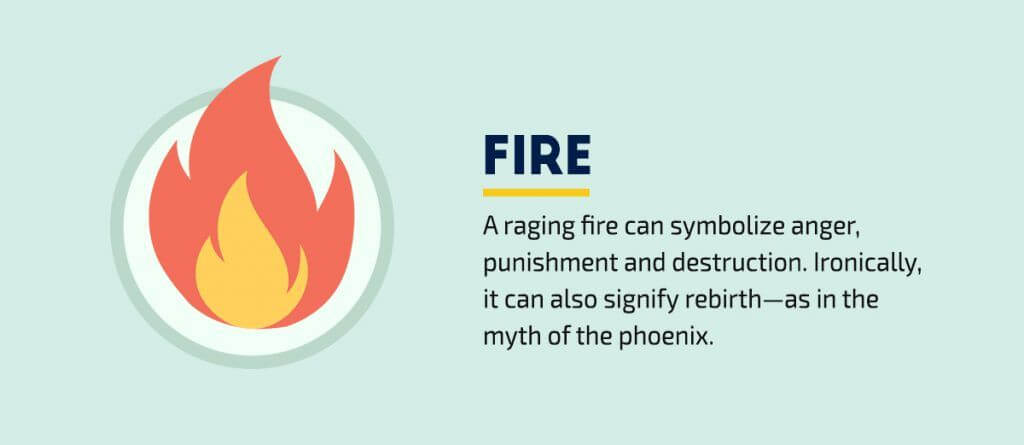
To understand the various interpretations and meanings of fire symbolism, delve into its significance in different contexts. Explore fire as a symbol of passion and desire, destruction and rebirth, illumination and knowledge, and purification and cleansing. Each sub-section unravels a unique facet of this powerful symbol.
Fire as a symbol of passion and desire
Fire has been a symbol of passion and desire for centuries. Its raw energy resonates with our deepest yearnings, feeding the flames of ambition. Fire’s ability to consume and transform reflects our own cravings for connection and ecstasy.
In mythology, fire was seen as a gift from the gods. It provided a form of self-expression and liberation for people to be true to themselves. Across literature and art, fire has been used to symbolize strong emotions, like the lovers in Romeo and Juliet whose love burned “like a torch”.
Legends of fire’s power remain in many cultures. One such tale tells of two star-crossed lovers whose love burned so brightly, even the jealous gods couldn’t extinguish it. They remain immortalized in the night sky.
Fire as a symbol of destruction and rebirth
Fire is a powerful, mesmerizing force of nature. It has long been seen as a symbol of destruction and rebirth. This dualistic symbolism shows both its destructive power and its capacity for renewal and transformation. Fire’s destructive side is clear – it can reduce anything to ashes, leaving only devastation. But within this destruction lies potential for new growth and regeneration.
Throughout history, fire has been associated with destruction. Ancient myths tell of gods using fire to punish or cleanse. Wildfires devastate entire ecosystems. Fire’s destruction is awe-inspiring – but it also serves a purpose, purging the old and making room for the new.
Fire symbolizes rebirth in its transformative nature. Flames consume matter, transforming it into something new and different. This mirrors the cycle of life – creation, destruction, and rebirth. Fire reduces matter to its most basic components, allowing for the creation of something new.
When considering fire, we must approach it with respect and caution. It can bring renewal, but it can also cause great harm if not handled properly. Fire is a powerful tool and must be used responsibly.
Fire as a symbol of illumination and knowledge
Fire is linked to illumination and knowledge. Its flickering flames fascinate people. It’s not merely a source of light – it symbolizes enlightenment.
Throughout history, fire has been a life-giver. It gave warmth, protection, and sustenance. Early societies used it to survive in hostile places.
In mythologies and religions, fire symbolizes knowledge and wisdom. In Greek mythology, Prometheus gave it to humanity, leading to progress. In Hinduism, Agni is the god of fire, seen as a mediator between humans and gods.
Symbolically, fire represents learning and understanding. Just like flames, knowledge is spread through curiosity. The flames also signify the quest for knowledge, shedding light on ignorance.
Fire has transformative powers. It can reduce objects to ashes or refine them. This mirrors the process of acquiring knowledge: old ideas are changed and refined.
For creative works or presentations on knowledge or illumination themes, visuals like candles or bonfires can be used to bring out the power of fire symbolism. This can help engage your audience.
Fire as a symbol of purification and cleansing
Fire is known for its bright and fierce nature. It symbolizes purification and cleansing. Its power eliminates impurities, bringing forth renewal. Fire consumes the old and makes way for the new, creating a sense of freshness and purity.
This symbolism is found in different cultures and religions. Hindus used fire in purification ceremonies. They’d walk through flames to cleanse themselves of sins and impurities. In Greek mythology, Hephaestus was the god of fire. He could cleanse both physically and spiritually.
Fire is also a powerful symbol of cleansing. Just like it burns away dead wood or debris, it can purify our lives by burning away negative energy or baggage. It’s often used metaphorically to represent personal growth or spiritual awakening. Fire shows us that we must let go of what doesn’t serve us, to embrace positive change.
Emily is an example of this symbolism. She found solace in burning her old journals. These contained memories of heartbreaks and painful experiences. As she watched the pages turn to ashes, she felt a sense of release and liberation. Burning her past allowed her to start anew and focus on creating a brighter future.
Fire Symbolism in Literature and Art
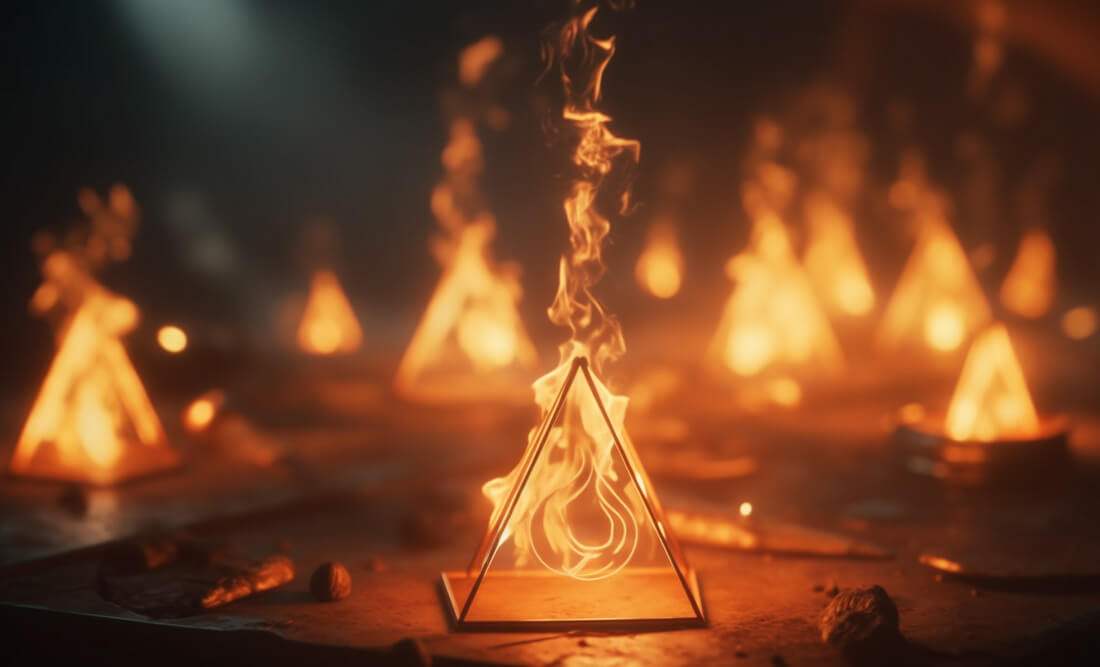
To better understand the significance of fire symbolism in literature and art, delve into the section discussing fire symbolism in literature and art. Explore examples of fire symbolism in literature that highlight its deeper meanings, as well as the use of fire symbolism in visual arts, where it serves as a powerful metaphor for various concepts.
Examples of fire symbolism in literature
Fire symbolism is a powerful device used in literature to communicate various meanings and emotions. It signifies passion, destruction, purification, and transformation.
To illustrate this, here are some examples of fire symbolism in literature:
- The Bible: In the Moses and burning bush story, fire is a representation of divine presence and enlightenment. It symbolizes God’s might and authority.
- Fahrenheit 451 by Ray Bradbury: Fire acts as a destructive power in this novel. The government uses it to burn books, suppressing knowledge and controlling society. Fire stands for censorship and tyranny.
- Jane Eyre by Charlotte Bronte: In this classic, fire is essential during the climax at Thornfield Hall. It symbolizes Jane’s personal transformation and liberation from societal norms.
In literature, fire is multi-faceted. It represents destruction and rebirth, showcasing the duality of human life. To understand fire symbolism better, take note of its context in the narrative. Analyze characters’ reactions and the underlying themes in the work. These details will help you appreciate the hidden meanings behind the symbol.
Pro Tip: When examining fire symbolism in literature, assess how it interacts with other symbols or motifs in the text. This will give you a better understanding of its role in the whole narrative.
The use of fire as a symbol of hope and renewal in “Fahrenheit 451”
Fire is a symbol of hope and renewal, as seen in Ray Bradbury’s “Fahrenheit 451.” In the book, fire is both destructive and a catalyst for change. Guy Montag, the firefighter, is tasked with burning books. But, he soon discovers that some people are willing to risk everything to protect them. Fire symbolizes rebellion and liberation. It sparks a desire for intellectual freedom.
Bradbury explores the transformative power of destruction. Burning books may seem like annihilation, but it leads to rebirth. New ideas are formed. Society learns from its past errors.
Fire also represents passion and emotion in the book. It shows how individuals can pursue their goals despite societal pressures.
In real life, fire is a metaphor for hope and renewal. An example is the Great Chicago Fire of 1871. Although it destroyed the city, it created a stronger sense of community. People came together to rebuild and created a stronger city.
The representation of fire as a destructive force in “To Build a Fire”
In “To Build a Fire,” fire is shown to be a destructive force. It stands as a symbol of the cruel reality of nature and the protagonist’s battle to live in extreme conditions. The tale portrays the devastating results of underestimating the potency of fire.
The man attempts to make a fire to keep himself warm, but his inexperience leads to dismal consequences. Initially, the fire is a source of hope, however, it gradually transforms into a fatal force due to his carelessness. This accentuates the unyielding nature of fire and its capability to ruin life when not respected.
Jack London uses striking descriptions to emphasize the destructive character of fire. He makes clear its uncontrollable energy, depicting it as a representation of both life-sustaining heat and deadly menace. The imagery creates a feeling of respect and fear for this powerful element.
Moreover, there is a deeper symbolic significance behind fire’s destructive role in the story. It portrays mankind’s battle against the forces of nature and our vulnerability in its presence. The man’s failure to handle fire successfully serves as a reminder that humans are not always in charge and must acknowledge nature’s strength.
To Build a Fire reveals a realistic atmosphere through its portrayal of fire as a destructive force. It is a warning, reminding us that even something seemingly beneficial can become lethal under certain conditions. By illustrating these dangers, London imparts valuable lessons of humility and survival.
Pro Tip: Always prioritize safety over convenience or speed when dealing with unfriendly environments or strange situations. Neglecting to do so might lead to serious repercussions.
The use of fire as a symbol of love and passion in poetry
Fire has long been a blazing symbol of love and passion in poetry. It evokes strong emotions and desire. Across history, it has highlighted the strong connection between fire and romantic love.
Let us look at some famous poems that use fire as a metaphor for love.
Here is a table showcasing notable works:
| Poem | Poet |
|---|---|
| “Love’s Fire” | William Shakespeare |
| “A Red, Red Rose” | Robert Burns |
| “She Walks in Beauty” | Lord Byron |
| “I Carry Your Heart with Me” | E.E. Cummings |
| “Wild Nights! Wild Nights!” | Emily Dickinson |
These poets show the intensity of their feelings through fire imagery. For example, Shakespeare’s sonnet “Love’s Fire” describes love as a devouring flame.
Fire has various nuances in different poems and literary periods. It can represent not only passionate desire but also destructive tendencies or even rebirth. This adds richness to romance in literature, giving readers a multifaceted view of human relationships.
Fire symbolism in visual arts
The use of fire symbolism in visual arts is mesmerizing. It adds depth and intensity to the artwork. Artists use it to convey emotions and concepts, creating a powerful impact.
Exploring fire symbolism in visual arts, we can discover different ways it has been used. For example, as a symbol of destruction and chaos. Artists use vibrant brushstrokes and intense colors to portray raging infernos and burning landscapes, evoking fear and turmoil.
It also symbolizes passion and desire. Flickering flames can represent raw emotion and attraction. They may dance in the eyes of lovers, or engulf figures in passionate embrace, igniting longing.
Fire can symbolize transformation and rebirth too. Phoenixes rising from ashes or individuals going through growth amidst adversity are often depicted with fire imagery. Its ever-changing nature mimics our own evolution.
This mesmerizing power urges us to reflect upon our emotions and desires. It reminds us life is fleeting and should be embraced.
So, experience these captivating artworks firsthand. Visit galleries and museums near you. Witness the enchantment that comes alive through fire symbolism. Let it ignite your senses and your imagination. Embrace the heat – it will leave an indelible mark on your artistic journey.
The depiction of fire in paintings and sculptures
Fire has been a popular symbol in literature and art for centuries. Painters and sculptors have been intrigued by its mesmerizing power and imagery. Fire can represent destruction, transformation, ardour, and knowledge.
In art, fire is often seen as a source of comfort and safety. Its vivid hues of red, orange, and yellow can evoke powerful emotions. The animation of flames can bring energy and life to a painting, captivating the viewer.
However, fire can also be portrayed as a destructive power that destroys all in its wake. In some artworks, fire is used to symbolize chaos, pandemonium, and the inevitability of change. It serves as a reminder that devastation is part of Nature’s cycle.
Gustave Doré’s painting “The Destruction by Fire” is an example of this. The painting shows a city consumed by flames, with people running away. The heat radiating from the canvas creates an atmosphere of urgency and alarm. Doré’s use of chiaroscuro technique adds drama, contrasting light and dark.
The use of fire as a symbol of transformation in photography
Fire, with its entrancing flames and intense heat, has been used as a potent symbol of transformation in photography. Utilizing fire in capturing images lets photographers express various emotions and themes. They evoke a feel of change and renewal.
Photography employs the visual force of fire to demonstrate transformation. Photographers can create impressive pictures by capturing the bright hues and dynamic nature of fire. The intense heat of fire can represent a transformation or the end of a momentous event, giving more value and meaning to the photo.
Besides, fire in photography can stand for personal growth and self-discovery. Fire burns everything it touches. People undergoing transformation usually go through a challenging period of inner change and self-reflection. By taking photos of this process, artists can show their own journey or reveal the transformative experiences of others.
In addition to its symbolic importance, using fire in photography brings certain difficulties. Fire is unpredictable and requires careful monitoring to ensure both safety and intended effects. Photographers must have a great level of skill and technique to take fire in all its glory while keeping the subject matter intact.
Overall, fire’s symbolism in photography is more than its natural beauty. It symbolizes transformation, growth, and change – ideas that touch viewers on a deeper level. By utilizing the might of fire in their works, photographers have the capability to craft visually arresting pieces that leave a lasting impression.
Trivia: Kevin Cooley’s series “Night for Night” is an amazing example of using fire as a symbol of transformation in photography. Cooley’s photographs splendidly capture burning trees at nightfall, representing ecological destruction while displaying nature’s immense resilience.
Contemporary Interpretations of Fire Symbolism

To gain a deeper understanding of contemporary interpretations of fire symbolism, explore the significance of fire in popular culture and its role in modern spirituality and self-development. Embrace the diverse perspectives and meanings associated with fire as you navigate through these sub-sections.
Fire symbolism in popular culture
Fire often stands for transformation and rebirth. In popular culture, it is used to depict characters or situations undergoing huge changes. Flames engulfing a person’s body as they become supernatural, or burning old memories to bring new beginnings, show this theme.
Fire also means destruction and power. It suggests overthrowing of old structures or showing a character’s formidable abilities. Images of fireballs, infernos or wildfires create a feeling of strength that attracts people.
Fire is associated with strong passions and intense emotions. Characters with fiery eyes, flaming hearts, or passionate embraces show the intensity of their feelings, adding life to their relationships.
Fire symbolism has deep roots in mythology and folklore from various parts of the world. From Prometheus bringing knowledge to humans, to the Hindu goddess Kali’s fiery wrath representing destruction and growth – fire has been a lasting symbol throughout cultures.
Fire symbolism in popular culture allows us to explore themes like transformation, destruction and power, as well as passion and desire. Both visual artistry and literary expressions touch audiences on a deeper level.
The use of fire as a symbol of rebellion in movies and TV shows
The symbol of fire has been used in movies and TV for a long time to represent rebellion. This fiery element is a visual metaphor for resistance and defiance against authority. Its mesmerizing dance captures the essence of revolution, bringing feelings of passion and intensity.
In films, fire is often portrayed as a symbol of uprising and transformation. Burning barricades or a torch held high are used to show a spirit of revolution. Directors use this symbolism to empower viewers and show characters’ journeys of resistance.
Fire is a literal and figurative tool of rebellion. It can be destructive, engulfing structures or inner turmoil. It’s primal instinct for survival taps into our deepest desires for change.
But fire has more uses than just rebellion. It can also signify passion, desire, purification, and destruction. Its versatility adds depth to storytelling and makes us question our beliefs.
Viewers can’t ignore the significance of fire symbolism in movies and TV. It captivates and stirs emotion, reminding us of our desire for freedom and justice. So next time you watch a movie or TV show, pay attention to how fire is used as a symbol of rebellion – you might find new layers of meaning.
The representation of fire as a symbol of power in video games
Fire is a symbol of strength, destruction and dominance in video games. It can be seen as a weapon, causing chaos and fear. Players use fire to overcome challenges, and its presence can build intensity. Fire also has ties to transformation and rebirth; characters may gain new abilities when exposed to it.
A great example of fire symbolism is the game “Dark Souls“. Fire is central to both narrative and gameplay. Bonfires provide light and hope in the dark world, and kindling them restores the player’s health. It also strengthens the character, enabling them to face tougher enemies. This intertwines fire with gameplay mechanics, giving the player a feeling of empowerment.
Fire symbolism in modern spirituality and self-development
Fire symbolizes energy, life, and renewal. It’s seen as a divine spark inside each person. Fire’s light encourages seekers to explore themselves and appreciate unique gifts. Fire is a reminder to let go of beliefs and accept personal progress.
Fire also links people to the natural world and its cycles. It symbolizes balance, since it needs oxygen but can be destructive. We must keep balance between our passions and responsibilities.
Fire has a special role in spiritual rituals for purification and renewal. By throwing away old patterns into the fire, individuals symbolically let go of burdens. Fire ceremonies open up new beginnings.
Pro Tip: When using fire symbolism, follow safety rules. Have the right tools like candles and incense cones made for rituals.
The use of fire rituals and ceremonies for personal transformation
Fire rituals and ceremonies have been a powerful tool for transformation for centuries. The energy and passion of fire symbolize purification, making it perfect for inner growth.
Engaging in fire rituals allows people to access their subconscious and let go of unhelpful emotions and beliefs. Intentionally channeling these thoughts into the flames signifies releasing the old and welcoming the new.
These ceremonies also offer catharsis and renewal as offerings or affirmations are consumed by the flames. This process can be deeply healing and transformational, allowing people to start afresh with clarity and purpose.
Fire rituals vary across cultures, yet the underlying symbolism is the same. Whether it’s bonfire rituals or spiritual retreats, people from all backgrounds find solace in the power of this ancient element.
A story illustrates the positive change from fire rituals. A woman who had long suffered from self-doubt attended a ceremony led by a shaman. As she wrote down her insecurities and offered them to the flames, she felt a huge weight being lifted.
This was the moment she realized her self-doubt had been holding her back. The ritual enabled her to release those limiting beliefs and reach her full potential. She stepped into her power with confidence and went on to achieve great success.
The use of fire symbolism continues to inspire people all over the world as they seek personal transformation. Acknowledging the power of this practice helps people embark on a journey of self-discovery and ignite their inner spark for a life of purpose and fulfillment.
The exploration of fire symbolism in meditation and visualization practices
Fire symbolism has long been used in meditation and visualization. It stands for transformation, passion, and vitality. People utilize it to tap into their inner energy and evoke motivation.
They visualize themselves surrounded by a radiant flame. Feel the warmth and intensity of the fire and let it fill you with new energy and power. This helps you let go of what no longer serves you and accept new beginnings.
Fire symbolism can also be used as a tool for manifestation. Visualizing your desires in the flames helps infuse your intentions with determination. This aligns your thoughts, emotions, and actions towards achieving your goals.
It also evokes feelings of passion and creativity. Connect with the fiery energy within yourself and experience a surge of enthusiasm. This newfound passion can fuel your creative endeavors and inspire you to pursue your passions.
Fire symbolism holds immense power. It represents physical heat and spiritual illumination. It ignites our inner spark and encourages us to embrace our potential. Embrace the transformative energy of fire and allow it to guide you towards positive change. Allow the fire to ignite your spirit!
Frequently Asked Questions
Q: What does fire symbolize?
A: Fire symbolizes various elements such as passion, energy, transformation, purification, destruction, and renewal. It represents both creation and destruction in different contexts.
Q: How is fire represented in different cultures?
A: Fire holds significant symbolism across cultures. For example, in ancient Greek mythology, fire was associated with the god Hephaestus, representing divine creativity. In Hindu culture, fire symbolizes purity and is used in sacred rituals. Native American tribes often associate fire with protection and the presence of the divine.
Q: What are some common fire symbols in literature and art?
A: Fire often appears as a symbol in literature and art to convey various meanings. Some common fire symbols include a burning candle symbolizing hope or enlightenment, a raging bonfire representing passion or chaos, and a flickering flame denoting fragility or vulnerability.
Q: What does the color of fire symbolize?
A: The color of fire can hold symbolic meaning too. A red flame typically represents strong emotions like love or anger, while a blue flame may symbolize calmness, spirituality, or intellectual pursuits. The intensity of the color can also indicate the strength or significance of the symbolism.
Q: How does fire symbolize transformation?
A: Fire’s transformative symbolism stems from its ability to turn matter into ash and create space for new beginnings. It symbolizes personal growth, reinvention, and the shedding of the old to pave the way for the new. Fire’s transformative power is often used as a metaphor for spiritual or emotional change.
Q: Can fire symbolize both positive and negative aspects?
A: Yes, fire symbolizes both positive and negative aspects depending on the context. While it represents passion, energy, and enlightenment, it can also stand for destruction, chaos, and danger. Fire’s symbolism highlights the duality of life’s forces and the importance of balance.
Conclusion
To conclude, wrap up your understanding of fire symbolism with a brief recap of its importance and diverse meanings. Reflect on the enduring fascination with fire as a symbol throughout history and in contemporary society for a comprehensive understanding.
Recap of the importance and diverse meanings of fire symbolism
Fire symbolism is very important and has a range of meanings. This strong symbol has been honoured by many cultures, for its capacity to create and destroy. Fire is linked to intensity, transformation and passion. It symbolises the never-ending cycle of creation and destruction, embodying both life-giving warmth and damaging force.
In old mythology, fire was seen as a heavenly element connecting humans and gods. It was thought to have purifying powers, able to clean the soul. Fire ceremonies were done to recognize gods, ask for good luck or blessings. In certain cultures, fire represented the very essence of life, symbolising energy and vitality.
In addition, fire has religious symbolism. In Christianity, it is usually linked to the Holy Spirit and divine guidance. For instance, the burning bush that spoke to Moses in the bible is an illustration of this connection. Fire also stands for enlightenment and spiritual awareness in several spiritual beliefs.
Moreover, fire symbolism extends beyond religion and mythology to everyday life. It can represent ambition, drive and passion – the burning desire in one to reach their objectives. Fire’s energy can spark creativity and new ideas, motivating artistic expression and personal growth.
A great example of fire’s symbolic strength is the story of the young artist, Maya Rodriguez. Struggling with self-doubt and creative blockage for months, Maya attended a transformational art retreat focused on sparking inner fire through art. Through guided meditation and painting exercises centred on fire, Maya reignited her love for art and found her unique style.
Reflection on the enduring fascination with fire as a symbol throughout history and in contemporary society
Fire has intrigued us for centuries, embodying power and representing destruction, love, purification and enlightenment. Ancient cultures held fire sacred, with rituals involving it playing a central role. In literature, it has been used to signify destruction and passion. In modern times, fire is seen in advertising, movies and TV, used to convey intensity or mark transformation.
Studying fire’s cultural meaning across different societies and fire safety helps us appreciate its destructive power and responsibility to control it.



